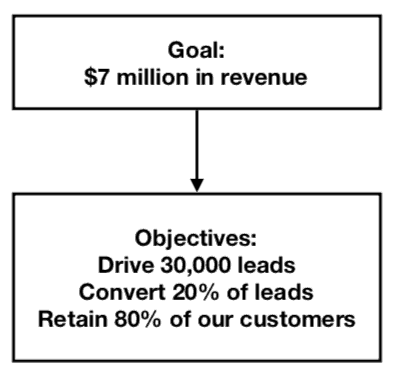
A few weeks ago we were talking about a model to help create a strategic marketing plan. This was when you could still go to a restaurant or to the movies. Those days seem like forever ago but I want to finish up this series.
With the world in turmoil and the future uncertain, it may seem like a plan would be useless but it still provides plenty of value. I’ll talk about that more in a couple of weeks but to have that conversation requires we finish our interrupted GSOT conversation.
This week we are going to talk about objectives. I find that objectives and goals are sometimes confused. Some people may think of objectives and goals as different words for the same thing. Kind of like public relations and earned media.
Objectives and goals are somewhat similar but they are different. So the question becomes, what is an objective and where does it fit into planning?
Where Do Objectives Fit?
Let’s talk about where objectives fit first. They are the third step in GSOT which is:
- Goals
- Strategy
- Objectives
- Tactics
Let’s do a quick review.
In the first post, we talked about goals. They are the broad primary outcomes an organization wants to achieve. A goal could be the organization wants to make $7 million in revenue for the year.
The next step is strategy. This is how you are going to achieve your goals. You are going to create blog content on your website which will be shared on your Facebook, Twitter, and LinkedIn pages to drive leads back to the website. You will also run ads on LinkedIn and work to place similar content with media who cover your industry to drive leads back to the website.
The next step is to create objectives but what are they?
What are Objectives?
Objectives are the measurable steps that help you achieve your goals. Sometimes it feels like goals and objectives get confused. There are similarities such as both are measurable and specific. They are also very different.
I have a background that includes project management so I tend to think of GSOT within that framework.
Your goals are broad. Your objectives are more specific. Think of them this way. If you broke down your goal into pieces, those pieces would be the objectives. Another way to put it is, objectives are markers that have to be achieved in order to reach a goal.
Let me give you a simple example to illustrate.
You’re having a dinner party. That’s your goal. What do you need for the party?
You need an appetizer, a main dish, a side dish, drinks, and a dessert. These are your objectives. When you have all these items, you are ready to have your dinner party.
The goal is the dinner and it’s broad in nature. The objectives are more specific. They are things you need to have in order to have the dinner party.
Determining Objectives
To determine your objectives, look at your goals and break them down.
If the goal is to make $7 million in revenue how many leads would you need? How many of those leads would you need to convert to a sale? How many widgets would you need to sell? How many customers would you need to retain? What kind of conversion rate would you need for each of your marketing communication activities?
These are the type of questions you want to ask. It’s no complete list but it is a starting point.
If we play the above example out, it might look something like this:

That gives you an idea but let’s look at a specific example and break it down so you can see the process in action. I warn you, this is going to require some math.
The goal is $1 million in revenue. The product you sell costs $500 and it’s only sold on your website. You want a conversion rate of 20%
How much product do you need to sell? It’s a matter of division. 1 million ÷ 500 = 2000. So we now know you need to 2000 sales/conversions.
How many leads do you need?
We take the information we already have to figure it out. You need 2000 people to make a purchase and your website needs to convert 20% of leads to a sale. 2000 sales/conversions ÷ 20% conversion rate = 10,000 leads.
Your objectives are:
- Drive 10,000 leads to the website
- Convert 20% of leads to customers/sales
- 2000 conversions/sales
That’s a simple example but you get the point.
Final Thoughts
Don’t overcomplicate it. Believe me, I know how to complicate simple things but even complex things can be broken down into a series of steps.
You started with goals that were broad. Now you are determining what you need to reach those goals. The objectives are more specific and they must be measurable.
Questions or comments? Talk to me in the comments.
- The Importance of Creating a Connection With Your Marketing - June 6, 2024
- Reach vs Visibility: Which is Right for Your Marketing? - February 13, 2024
- Focus Your Marketing Efforts By Saying “No” - December 13, 2023

